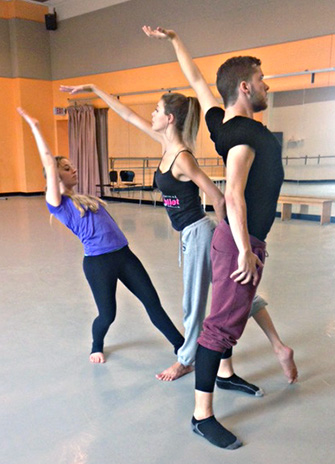Thirty-six new works will debut Nov. 26 to 28 in Dance Innovations: Strong/Light, a choreographic showcase of York University’s Department of Dance.

York’s rising young dance artists step into the spotlight with three distinctive programs of original choreography, presented in the McLean Performance Studio, 244 Accolade East Building on York’s Keele campus.
Dance Innovations: Strong/Light is directed by celebrated independent choreographer, writer and York dance Professor Carol Anderson. The crews – including board and lighting operators, assistant stage managers, projections, and many front-of-house positions – are students in the production course led by Dance Innovations production director Professor William Mackwood.
The showcase is a collaboration with the Department of Theatre, and most of the dances will be lit by students in a stage lighting course taught by Steve Ross.
The title Strong/Light refers to the continuum of effort from strong to light in the Laban system of movement analysis. Students are working with choreographic investigation of dynamic variation, and motif and development in their choreographic projects.
Most of the featured choreographies are created by fourth-year students in York’s BFA program in dance. Works by MFA candidates, as well as an ensemble piece created by Professor Darcey Callison for third-year dance majors, round out the program.

Callison’s “Post Baroque” brings together the structural inquiry of post-modern dance (1962 to 1979) and the decorative sensibilities of baroque dance (1690 to 1750). Although these two periods are often viewed as aesthetic opposites, they both valued the harmonious connections between the body and patterns in nature, and attempted to show intrinsic order within disorder.
Several student choreographers found inspiration for their works in the many facets of human relationships. Mariah Awaiye’s untitled duet explores the overwhelming power of attachment; Natalie Chung’s trio “Linked” is about getting to know one another; and Becca Graziano’s duet “Perhaps I am a tumbleweed” investigates intimacy through space, touch and eye contact. Testing the limits of mind and body is the theme of Tori Kelly’s “Begin, Risk, Stop”; Jessica Irwin’s “Unbound” and Rosie Kimble’s “Alone, Together” look at how secrecy plays out in relationships; and “Disintegration,” a quintet by Stefanie Stefanov, explores the battle underlying the dissolution of love.
Looking inward and examining the self is another thematic connection within Strong/Light. Colleen Dingeldein’s “Two” looks at how it is possible for us to feel trapped in our own bodies; Emily Griffiths’ “Em’s Gems” is about self-expression; and Jessica Mannara’s “(IN)Consinnus” questions elegance and vanity. “Saudades” (Longing) by Kyle Manraj is inspired by traditional Portuguese fado music; Dedra McDermott choreographs a soul’s awakening; and Deuana Robinson’s “Posy” compartmentalizes the female body. Juliana Roman’s sextet “Interius Daemones” (Inner Demons), explores overcoming addiction; Rebekah Spence’s duet “Faith” focuses on the relationship between religion and hope; and “Heart Cry,” a duet by Selina Twum, explores struggle and strength.
Four students dance around the clock, looking forward or back in time. Madison Burgess’ “among the memories” recalls the distant past; “Moirai” by Marivic de Vera explores destiny and memory; Natalie Feigin’s duet “Raisa” is a eulogy for a girl who did not survive the Holocaust; and Victoria Gubiani’s “A Cry of the Romantics” explores the free expression and rebellion that empowered art and literacy in the Romantic Era.
Other choreographers take inspiration from the natural world. Heather Carter’s “From the Ground Up” evokes a plant’s metamorphosis from seed to maturity; Crystal Finn-Dunn’s sextet is driven by qualities of an amoeba; Tenzin-Tara Haines-Wangda’s quartet “In the Lab” is about clearing one’s mind; “Tempest” by Kate Kovach embodies the dynamics of storms from different perspectives; and Danielle Wake’s trio “Predatory” shows the animalistic physicality of a cheetah pursuing its prey.

The geometry of dance is also a thematic focus. “Oblivion,” a trio by Amber Davis, explores improvised movement through space; Chloe Munday’s “A Sense of Rush!” deploys strength and dynamism in diverse spatial patterns; Christina Logan’s trio “Embers” displays directionality, contact and focus; and Bianca Trulli’s quintet “One-off” is an exploration of movement.
Six choreographers from York’s graduate program in dance contribute arresting new works to the playbill. Ashley Burton’s playful duet “vin pour deux, s’il vous plait” takes the audience on a Parisian adventure; Caitlin Elmslie’s trio “Next Level” illustrates the effects of similar movements expressed at various levels in space; “With(in) Thyself,” a quintet choreographed by Rose Hajas, explores one person’s experience of dissociation and disconnection from reality; Em Leonard’s “Romeo and Juliet” focuses on lesbian, gay, polyamorous and asexual stories; Suzanne Liska’s “Elemental” explores the journey around uniting elemental states; and Lexie Strachan’s “Convergence” stems from the idea that a dancer’s creative possibilities are endless.
The performance runs in three programs: Program A, Program B and Program C on all three days, with evening and afternoon performances scheduled.
Admission to each program of Dance Innovations: Strong/Light is $18, or $12 in advance (before Nov. 22). For more information, for a complete schedule or to purchase tickets, visit ampd.yorku.ca/perform/boxoffice or call 416-736-5888.


